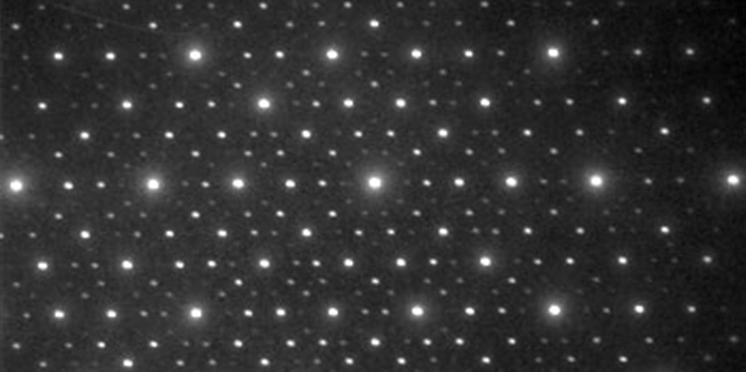electron-probe diameter, probe diameter
electron-probe diameter, probe diameter
The electron-probe diameter (probe diameter) means the diameter of the incident electron probe focused onto the specimen surface.
The following equation is widely used for the definition of the probe diameter.

The upper equation represents that the probe diameter d at the specimen surface is obtained by the root mean square of four terms, or d0 (probe diameter obtained by an electron source with no aberration), dd (probe diameter determined by diffraction aberration), ds (probe diameter of the minimum confusion circle determined by spherical aberration) and dc (probe diameter of the minimum confusion circle determined by chromatic aberration). The lower equation expresses specific descriptions of d0, dd, ds and dc. Here, Ip is the probe current, β is the brightness of the electron gun, α is the convergence semi-angle of the electron probe, λ is the electron wavelength, Cs is the spherical aberration coefficient of the objective lens, Cc is the chromatic aberration coefficient of the objective lens, E is the energy of the electron beam and ΔE is the energy spread of the electron beam. The equation shows that the probe diameter d is a function of the convergence semi-angle α of the electron probe.
Fig. 1 shows the probe diameter d as a function of the convergence semi-angle α for an ordinary SEM equipped with a thermionic-emission electron gun (tungsten filament) operating at an accelerating voltage of 20 kV. The parameters used here are as follows: E=20 keV, ΔE=1 eV, Cs=50 mm, Cc=20 mm, β=7×104 A/cm2/sr, and Ip=1 pA, 10 pA and 100 pA (three cases). It is noted that the three probe currents Ip correspond to the cases: a small probe current for high spatial-resolution observation, a large probe current for element analysis, a medium probe current for compromising high-resolution observation and element analysis.
The black curve for Ip = 100 pA shows that the probe diameter d is determined mainly by d0 and ds, where d0 is the probe diameter due to the electron source and ds is the probe diameter due to spherical aberration. The black curve for Ip = 1 pA indicates that the probe diameter d suffers the contribution of the probe spread due to chromatic aberration dc. It is seen that the smallest probe diameter d is ~33 nm for the former case (Ip : 100 pA) and ~7 nm for the latter case (Ip : 1 pA). In order to decrease the probe diameter d for acquiring a high spatial-resolution image, first α that minimizes d is examined by numerical calculations, and then α is set to the calculated value by selecting an objective aperture (diameter) or by adjusting the excitation of the lens to control α.
Fig. 2 shows the probe diameter d as a function of the convergence semi-angle α for an SEM equipped with a Schottky electron gun operating at accelerating voltages of 1 kV and 20 kV. The parameters used are as follows: E=1 keV and 20 keV (two cases), ΔE=0.5 eV, Cs=4 mm, Cc=2 mm, β=1×108 A/cm2/sr and Ip=1 pA . In the case of an SEM equipped with a Schottky electron gun, the probe diameter d is determined mainly by dd (probe spread due to diffraction aberration) and ds (probe spread due to spherical aberration) for the accelerating voltage of 20 kV, but is determined mainly by dd (probe spread due to diffraction aberration) and dc (probe spread due to chromatic aberration) for the accelerating voltage of 1 kV. It is seen that the smallest probe diameter d is ~1 nm for the accelerating voltage of 20 kV and ~7 nm for the accelerating voltage of 1 kV. As the accelerating voltage is lowered, the probe diameter becomes large due to the increase of the chromatic aberration.
In the case of an ordinary SEM equipped with a thermionic-emission electron gun, the smallest probe diameter of ~7 nm is obtained only at a high accelerating voltage of 20 kV. On the other hand, in the case of an SEM equipped with a Schottky electron gun, a similar diameter of ~7 nm is obtained even at a very low voltage of 1 kV. This is because d0 (probe diameter obtained by the electron source with no aberration) of the Schottky electron gun is significantly smaller than that of the thermionic-emission electron gun (tungsten filament).

Fig. 1 Probe diameter d (black line) for an ordinary SEM equipped with a thermionic-emission electron gun. The abscissa represents convergence semi-angle α.

Fig. 2 Probe diameter d (black line) for a high-resolution SEM equipped with a Schottky electron gun. The abscissa represents the convergence semi-angle α.
Related Term(s)
Term(s) with "electron-probe diameter, probe diameter" in the description
Are you a medical professional or personnel engaged in medical care?
No
Please be reminded that these pages are not intended to provide the general public with information about the products.




